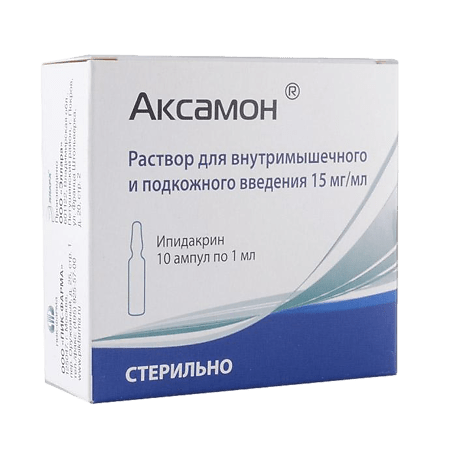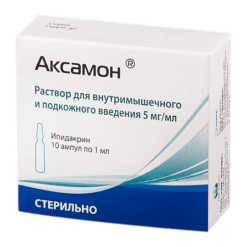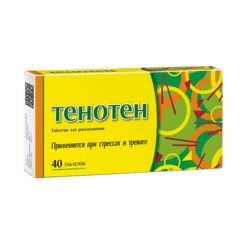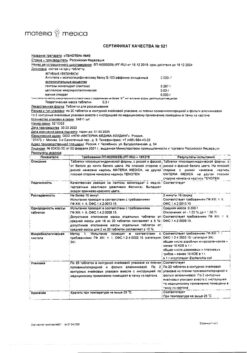No products in the cart.
Axamon, 15 mg/ml 1 ml 10 pcs
€51.31 €47.76
Description
Axamon® is a reversible cholinesterase inhibitor and directly stimulates impulse conduction at the neuromuscular synapse and in the central nervous system (CNS) due to blockade of membrane potassium channels. It enhances the effect on smooth muscles not only of acetylcholine but also of adrenaline, serotonin, histamine and oxytocin.
Axamon® has the following pharmacological effects:
– improves and stimulates impulse conduction in the nervous system and neuromuscular transmission;
– improves conduction in the peripheral nervous system, impaired due to trauma, inflammation, exposure to local anesthetics, some antibiotics, potassium chloride, etc.
– increases smooth muscle contractility under the influence of agonists of acetylcholine, adrenaline, serotonin, histamine and oxytocin receptors, except for potassium chloride;
– improves memory, inhibits progradient development of dementia.
It does not have teratogenic, embryotoxic, mutagenic, carcinogenic and immunotoxic action. It does not affect the endocrine system.
Pharmacokinetics
In subcutaneous and intramuscular administration, it is rapidly absorbed. Maximum concentration in blood is reached 25-30 min after administration. Binding with plasma proteins is 40-50%.
The drug is rapidly absorbed into the tissues. It is metabolized in the liver. Excretion of the drug is carried out through the kidneys (mainly by tubular secretion and only 1/3 by glomerular filtration) and extrarenal (through gastrointestinal tract).
The elimination half-life of Axamon® during parenteral administration is 2-3 hours. After parenteral administration 34.8% of the drug dose is excreted unchanged in the urine.
Indications
Indications
— Diseases of the peripheral nervous system: mono- and polyneuropathy, polyradiculopathy, myasthenia gravis and myasthenic syndrome of various etiologies;
— diseases of the central nervous system: bulbar paralysis and paresis, the recovery period of organic lesions of the central nervous system, accompanied by motor disorders;
– intestinal atony.
Pharmacological effect
Pharmacological effect
Axamon® is a reversible cholinesterase inhibitor that directly stimulates impulse conduction at the neuromuscular synapse and in the central nervous system (CNS) due to blockade of membrane potassium channels. It enhances the effect on smooth muscles of not only acetylcholine, but also adrenaline, serotonin, histamine and oxytocin.
Aksamon® has the following pharmacological effects:
– improves and stimulates impulse conduction in the nervous system and neuromuscular transmission;
– improves conductivity in the peripheral nervous system, impaired due to injury, inflammation, exposure to local anesthetics, some antibiotics, potassium chloride, etc.;
– enhances the contractility of smooth muscle organs under the influence of agonists of acetylcholine, adrenaline, serotonin, histamine and oxytocin receptors, with the exception of potassium chloride;
– improves memory, inhibits the progressive development of dementia.
Does not have teratogenic, embryotoxic, mutagenic, carcinogenic or immunotoxic effects. Does not affect the endocrine system.
Pharmacokinetics
When administered subcutaneously and intramuscularly, it is quickly absorbed. The maximum concentration in the blood is achieved 25-30 minutes after administration. Binding to blood plasma proteins is 40-50%.
The drug quickly enters the tissues. Metabolized in the liver. The drug is excreted through the kidneys (mainly by tubular secretion and only 1/3 by glomerular filtration) and extrarenally (through the gastrointestinal tract).
The half-life of Axamon® when administered parenterally is 2-3 hours. After parenteral administration, 34.8% of the drug dose is excreted unchanged in the urine.
Special instructions
Special instructions
Impact on the ability to drive vehicles and operate machinery
During treatment, you should refrain from driving a car, other vehicles and machinery, as well as from engaging in potentially hazardous activities that require increased concentration and speed of psychomotor reactions.
Active ingredient
Active ingredient
Ipidacrine
Composition
Composition
Solution for intramuscular and subcutaneous administration 1 ml
active substance:
ipidacrine hydrochloride monohydrate (calculated as anhydrous) 15 mg
excipients:
0.1 M hydrochloric acid solution – to pH 3;
water for injection – up to 1 ml
Pregnancy
Pregnancy
The use of the drug increases the tone of the uterus and can lead to premature birth, therefore ipidacrine is contraindicated during pregnancy.
There are no data on the use of the drug during breastfeeding.
Contraindications
Contraindications
— Epilepsy;
— extrapyramidal disorders with hyperkinesis;
– angina pectoris;
– severe bradycardia;
— bronchial asthma;
— mechanical obstruction of the intestines or urinary tract;
— vestibular disorders;
– peptic ulcer of the stomach or duodenum in the acute stage;
– children under 18 years of age (there is no systematic data on use in children);
– hypersensitivity to any of the components of the drug.
Prescribed with caution for gastric and duodenal ulcers, thyrotoxicosis, diseases of the cardiovascular system, a history of obstructive diseases of the respiratory system or acute respiratory diseases.
Side Effects
Side Effects
The frequency of adverse reactions that may occur during use of the drug is given in the following classification: very common (>1/10 prescriptions), common (1/10-1/100 prescriptions), uncommon (1/100-1/1000 prescriptions), rare (1/1000-1/10,000 prescriptions), very rare (<1/10,000 prescriptions) and unknown frequency (frequency cannot be calculated from available data).
From the mental side: infrequent – drowsiness.
From the nervous system: infrequent – dizziness, headache, convulsions; unknown frequency – tremor.
From the organ of vision: unknown frequency – miosis.
From the side of the heart: frequent – palpitations, bradycardia; unknown frequency – pain behind the sternum.
From the respiratory system: infrequent – increased secretion of bronchial secretions.
From the gastrointestinal tract: frequent – drooling, nausea; infrequent – vomiting; rare – diarrhea, epigastric pain.
From the liver and biliary tract: unknown frequency – jaundice.
From the skin and subcutaneous tissues: infrequently – itching, rash.
General disorders and disorders at the injection site: frequent – increased sweating; infrequent – general weakness; unknown frequency – hypothermia.
Salivation and bradycardia can be reduced with m-anticholinergic drugs (including atropine, cyclodol, metacin).
If itching or rash occurs, stop taking the drug. In other cases, reduce the dose or interrupt the drug for a short time (for 1-2 days).
Interaction
Interaction
The risk of developing bradycardia increases if beta-blockers were used before starting treatment with Axamon®.
Reduces the inhibitory effect of local anesthetics, aminoglycosides, potassium chloride on neuromuscular transmission and conduction of excitation along peripheral nerves.
Axamon® can be used in combination with nootropic drugs.
Ethanol increases the side effects of the drug.
Overdose
Overdose
Symptoms: decreased appetite, bronchospasm, lacrimation, increased sweating, constriction of the pupils, nystagmus, increased gastrointestinal peristalsis, spontaneous bowel movements and urination, vomiting, jaundice, bradycardia, intracardiac conduction disturbances, arrhythmias, decreased blood pressure, anxiety, anxiety, agitation, fear, ataxia, convulsions, coma, disorders speech, drowsiness and general weakness.
Treatment: use of m-anticholinergic drugs (including atropine, cyclodol, metacin), symptomatic therapy.
Storage conditions
Storage conditions
In a place protected from light, at a temperature not exceeding 25 °C
Shelf life
Shelf life
2 years
Manufacturer
Manufacturer
Ellara LLC, Russia
Additional information
| Shelf life | 2 years |
|---|---|
| Conditions of storage | In a light-protected place, at a temperature not exceeding 25 °C |
| Manufacturer | Ellara, Russia |
| Medication form | solution |
| Brand | Ellara |
Other forms…
Related products
Buy Axamon, 15 mg/ml 1 ml 10 pcs with delivery to USA, UK, Europe and over 120 other countries.















